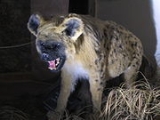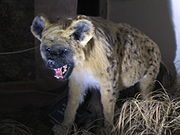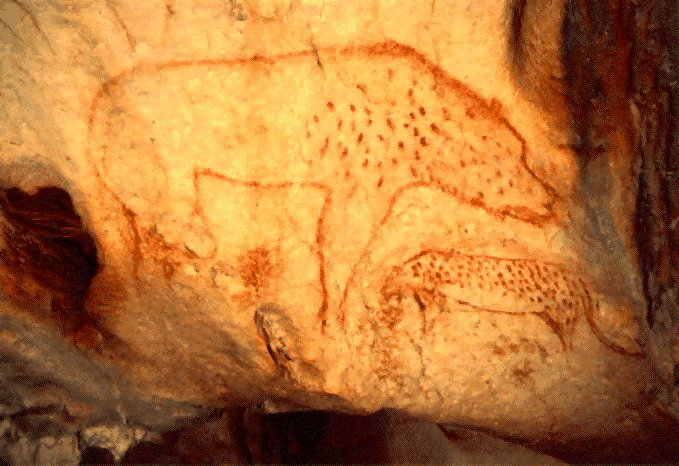
Cave Hyena
Encyclopedia
The Cave Hyena is an extinct subspecies
of spotted hyena
(Crocuta crocuta) native to Eurasia
, ranging from Northern China
to Spain
and into the British Isles
. Though originally described as a separate species from the spotted hyena due to large differences in fore and hind extremities, genetic analysis indicates no sizeable differences in DNA
between Pleistocene
cave hyena and modern day spotted hyena populations. It is known from a range of fossils and prehistoric cave art. With the decline of grasslands 12,500 years ago, Europe experienced a massive loss of lowland habitats favoured by cave hyenas, and a corresponding increase in mixed woodlands. Cave hyenas, under these circumstances, would have been outcompeted by wolves and human
s which were as much at home in forests as in open lands, and in highlands as in lowlands. Cave hyena populations began to shrink after roughly 20,000 years ago, completely disappearing from Western Europe
between 14-11,000 years ago, and earlier in some areas.
_-_jungpleistozn.jpg) The main distinction between the spotted hyena and the cave hyena is grounded on different lengths of the hind and fore limb bones. The humerus
The main distinction between the spotted hyena and the cave hyena is grounded on different lengths of the hind and fore limb bones. The humerus
and femur
are longer in the cave hyena, indicating an adaptation to a different habitat to that of the spotted hyena. It is unknown if they showed the same sexual dimorphism
of the spotted hyena. It has been estimated that they weighed 102 kg (225 lbs).
Little is known of their social habits. It is widely accepted that they used caves as dens, although sites in the open-air are also known. There is no indication of cave hyenas living in large clans or on a more solitary basis, though large clans are not considered likely in their Pleistocene habitat.
 Like modern hyenas, cave hyenas accumulated the bones and horns of their food at den sites for later consumption or for play, though it is unknown if the discovered remains were from scavenged or killed animals. Studies of animal remains in hyena den sites in the Bohemian Karst show that Przewalski's Horse
Like modern hyenas, cave hyenas accumulated the bones and horns of their food at den sites for later consumption or for play, though it is unknown if the discovered remains were from scavenged or killed animals. Studies of animal remains in hyena den sites in the Bohemian Karst show that Przewalski's Horse
s were apparently their most common prey, which amounted to 16-51% of the cave hyena's prey. Their largest prey was the woolly rhinoceros
, the bones and skulls of which have been found in many hyena den sites. In some regions, rhino remains can comprise 25-30% of the total prey bone material in den sites. Reindeer
were another important food source, as they made up 7-15% of the cave hyena's prey. The Steppe Wisent
made up only 1-6% of the cave hyena's prey. Red deer
only comprised 3% of found remains, with Irish elk
being even rarer. The remains of alpine fauna including chamois
and ibex are absent in some places, representing less than 3% of the prey, possibly due to their greater fragility. There is evidence that cave hyenas occasionally practiced cannibalism
.
and wolf remains in areas where they are sympatric with hyenas.
Cave hyenas are thought to be responsible for the dis-articulation and destruction of some cave bear skeletons. Such large carcasses were an optimal food resource for the hyenas, especially at the end of the winter, when food was scarce.
Cave hyenas were sympatric with gray wolves in Italy
. Unlike the hyenas, which preferentially preyed on lowland animals such as horses, wolves relied more on smaller, slope-dwelling prey such as ibex and roe deer, thus minimizing competition. Wolves and cave hyenas seem to display negative abundance relations over time, with wolf populations expanding their ranges as hyenas disappeared.
 Kills partially processed by Neanderthal
Kills partially processed by Neanderthal
and then by cave hyena indicate that hyena would occasionally steal Neanderthal kills, and cave hyena and Neanderthal both competed for cave sites. Many caves show alternating occupations of hyenas and Neanderthals. Numerous hominid bones, including Neanderthal, have also been found partially consumed by cave hyena. Modern humans also lived alongside cave hyena, and may have had similar interaction with them. Some paleontologists believe that competition and predation by cave hyenas in Siberia was a significant factor in delaying human colonization of Alaska
. Cave hyenas may have occasionally stolen human kills, or entered campsites to drag off the young and weak, much like modern spotted hyenas in Africa. The oldest Alaskan human remains coincide with roughly the same time cave hyenas became extinct, leading certain paleontologists to infer that hyena predation was what prevented humans from crossing the Bering strait
earlier.
Subspecies
Subspecies in biological classification, is either a taxonomic rank subordinate to species, ora taxonomic unit in that rank . A subspecies cannot be recognized in isolation: a species will either be recognized as having no subspecies at all or two or more, never just one...
of spotted hyena
Spotted Hyena
The spotted hyena also known as laughing hyena, is a carnivorous mammal of the family Hyaenidae, of which it is the largest extant member. Though the species' prehistoric range included Eurasia extending from Atlantic Europe to China, it now only occurs in all of Africa south of the Sahara save...
(Crocuta crocuta) native to Eurasia
Eurasia
Eurasia is a continent or supercontinent comprising the traditional continents of Europe and Asia ; covering about 52,990,000 km2 or about 10.6% of the Earth's surface located primarily in the eastern and northern hemispheres...
, ranging from Northern China
China
Chinese civilization may refer to:* China for more general discussion of the country.* Chinese culture* Greater China, the transnational community of ethnic Chinese.* History of China* Sinosphere, the area historically affected by Chinese culture...
to Spain
Spain
Spain , officially the Kingdom of Spain languages]] under the European Charter for Regional or Minority Languages. In each of these, Spain's official name is as follows:;;;;;;), is a country and member state of the European Union located in southwestern Europe on the Iberian Peninsula...
and into the British Isles
British Isles
The British Isles are a group of islands off the northwest coast of continental Europe that include the islands of Great Britain and Ireland and over six thousand smaller isles. There are two sovereign states located on the islands: the United Kingdom of Great Britain and Northern Ireland and...
. Though originally described as a separate species from the spotted hyena due to large differences in fore and hind extremities, genetic analysis indicates no sizeable differences in DNA
DNA
Deoxyribonucleic acid is a nucleic acid that contains the genetic instructions used in the development and functioning of all known living organisms . The DNA segments that carry this genetic information are called genes, but other DNA sequences have structural purposes, or are involved in...
between Pleistocene
Pleistocene
The Pleistocene is the epoch from 2,588,000 to 11,700 years BP that spans the world's recent period of repeated glaciations. The name pleistocene is derived from the Greek and ....
cave hyena and modern day spotted hyena populations. It is known from a range of fossils and prehistoric cave art. With the decline of grasslands 12,500 years ago, Europe experienced a massive loss of lowland habitats favoured by cave hyenas, and a corresponding increase in mixed woodlands. Cave hyenas, under these circumstances, would have been outcompeted by wolves and human
Human
Humans are the only living species in the Homo genus...
s which were as much at home in forests as in open lands, and in highlands as in lowlands. Cave hyena populations began to shrink after roughly 20,000 years ago, completely disappearing from Western Europe
Western Europe
Western Europe is a loose term for the collection of countries in the western most region of the European continents, though this definition is context-dependent and carries cultural and political connotations. One definition describes Western Europe as a geographic entity—the region lying in the...
between 14-11,000 years ago, and earlier in some areas.
Description
_-_jungpleistozn.jpg)
Humerus
The humerus is a long bone in the arm or forelimb that runs from the shoulder to the elbow....
and femur
Femur
The femur , or thigh bone, is the most proximal bone of the leg in tetrapod vertebrates capable of walking or jumping, such as most land mammals, birds, many reptiles such as lizards, and amphibians such as frogs. In vertebrates with four legs such as dogs and horses, the femur is found only in...
are longer in the cave hyena, indicating an adaptation to a different habitat to that of the spotted hyena. It is unknown if they showed the same sexual dimorphism
Sexual dimorphism
Sexual dimorphism is a phenotypic difference between males and females of the same species. Examples of such differences include differences in morphology, ornamentation, and behavior.-Examples:-Ornamentation / coloration:...
of the spotted hyena. It has been estimated that they weighed 102 kg (225 lbs).
Little is known of their social habits. It is widely accepted that they used caves as dens, although sites in the open-air are also known. There is no indication of cave hyenas living in large clans or on a more solitary basis, though large clans are not considered likely in their Pleistocene habitat.
Dietary habits

Przewalski's Horse
Przewalski's Horse or Dzungarian Horse, is a rare and endangered subspecies of wild horse native to the steppes of central Asia, specifically China and Mongolia.At one time extinct in the wild, it has been reintroduced to its native habitat in Mongolia at the Khustain Nuruu...
s were apparently their most common prey, which amounted to 16-51% of the cave hyena's prey. Their largest prey was the woolly rhinoceros
Woolly Rhinoceros
The woolly rhinoceros is an extinct species of rhinoceros that was common throughout Europe and Asia during the Pleistocene epoch and survived the last glacial period. The genus name Coelodonta means "cavity tooth"...
, the bones and skulls of which have been found in many hyena den sites. In some regions, rhino remains can comprise 25-30% of the total prey bone material in den sites. Reindeer
Reindeer
The reindeer , also known as the caribou in North America, is a deer from the Arctic and Subarctic, including both resident and migratory populations. While overall widespread and numerous, some of its subspecies are rare and one has already gone extinct.Reindeer vary considerably in color and size...
were another important food source, as they made up 7-15% of the cave hyena's prey. The Steppe Wisent
Steppe Wisent
The Steppe Bison or steppe wisent was a bison found on steppes throughout Europe, Central Asia, Beringia, and North America during the Quaternary...
made up only 1-6% of the cave hyena's prey. Red deer
Red Deer
The red deer is one of the largest deer species. Depending on taxonomy, the red deer inhabits most of Europe, the Caucasus Mountains region, Asia Minor, parts of western Asia, and central Asia. It also inhabits the Atlas Mountains region between Morocco and Tunisia in northwestern Africa, being...
only comprised 3% of found remains, with Irish elk
Irish Elk
The Irish Elk or Giant Deer , was a species of Megaloceros and one of the largest deer that ever lived. Its range extended across Eurasia, from Ireland to east of Lake Baikal, during the Late Pleistocene. The latest known remains of the species have been carbon dated to about 7,700 years ago...
being even rarer. The remains of alpine fauna including chamois
Chamois
The chamois, Rupicapra rupicapra, is a goat-antelope species native to mountains in Europe, including the Carpathian Mountains of Romania, the European Alps, the Tatra Mountains, the Balkans, parts of Turkey, and the Caucasus. The chamois has also been introduced to the South Island of New Zealand...
and ibex are absent in some places, representing less than 3% of the prey, possibly due to their greater fragility. There is evidence that cave hyenas occasionally practiced cannibalism
Cannibalism
Cannibalism is the act or practice of humans eating the flesh of other human beings. It is also called anthropophagy...
.
Interspecific predatory relationships
Cave hyenas were highly successful predators, and were especially numerous in Northeast Asia, where it seems they outcompeted most other predators. This was deduced from the relative scarcity of cave lion, cave bearCave Bear
The cave bear was a species of bear that lived in Europe during the Pleistocene and became extinct at the beginning of the Last Glacial Maximum about 27,500 years ago....
and wolf remains in areas where they are sympatric with hyenas.
Cave hyenas are thought to be responsible for the dis-articulation and destruction of some cave bear skeletons. Such large carcasses were an optimal food resource for the hyenas, especially at the end of the winter, when food was scarce.
Cave hyenas were sympatric with gray wolves in Italy
Italy
Italy , officially the Italian Republic languages]] under the European Charter for Regional or Minority Languages. In each of these, Italy's official name is as follows:;;;;;;;;), is a unitary parliamentary republic in South-Central Europe. To the north it borders France, Switzerland, Austria and...
. Unlike the hyenas, which preferentially preyed on lowland animals such as horses, wolves relied more on smaller, slope-dwelling prey such as ibex and roe deer, thus minimizing competition. Wolves and cave hyenas seem to display negative abundance relations over time, with wolf populations expanding their ranges as hyenas disappeared.
Interactions with hominids

Neanderthal
The Neanderthal is an extinct member of the Homo genus known from Pleistocene specimens found in Europe and parts of western and central Asia...
and then by cave hyena indicate that hyena would occasionally steal Neanderthal kills, and cave hyena and Neanderthal both competed for cave sites. Many caves show alternating occupations of hyenas and Neanderthals. Numerous hominid bones, including Neanderthal, have also been found partially consumed by cave hyena. Modern humans also lived alongside cave hyena, and may have had similar interaction with them. Some paleontologists believe that competition and predation by cave hyenas in Siberia was a significant factor in delaying human colonization of Alaska
Alaska
Alaska is the largest state in the United States by area. It is situated in the northwest extremity of the North American continent, with Canada to the east, the Arctic Ocean to the north, and the Pacific Ocean to the west and south, with Russia further west across the Bering Strait...
. Cave hyenas may have occasionally stolen human kills, or entered campsites to drag off the young and weak, much like modern spotted hyenas in Africa. The oldest Alaskan human remains coincide with roughly the same time cave hyenas became extinct, leading certain paleontologists to infer that hyena predation was what prevented humans from crossing the Bering strait
Bering Strait
The Bering Strait , known to natives as Imakpik, is a sea strait between Cape Dezhnev, Chukotka Autonomous Okrug, Russia, the easternmost point of the Asian continent and Cape Prince of Wales, Alaska, USA, the westernmost point of the North American continent, with latitude of about 65°40'N,...
earlier.

